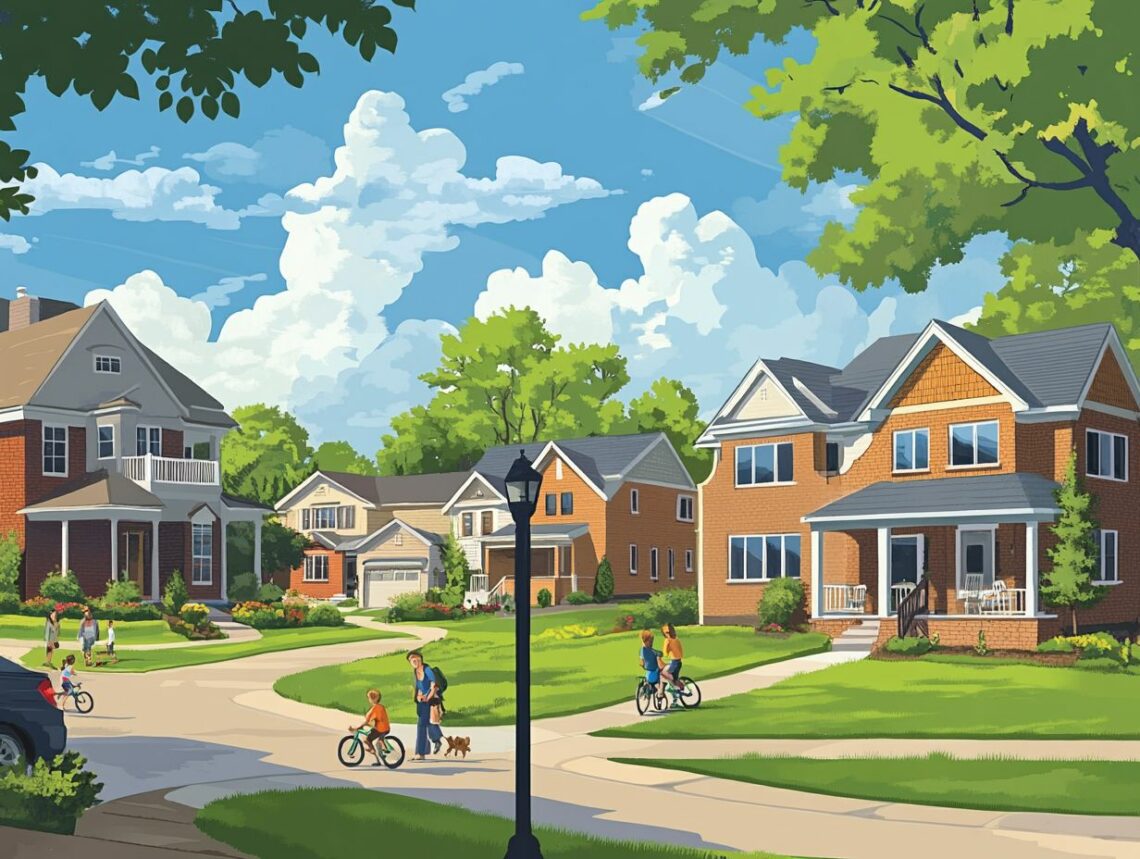
How to Choose the Perfect Home Location
Choosing the perfect home location is one of the most crucial decisions you’ll make in your home-buying journey.
Beyond just bricks and mortar, your home’s location significantly impacts your lifestyle, convenience, and future investment potential.
This article will guide you through key factors that define an ideal setting, such as proximity to amenities, neighborhood trends, and future development.
We will also provide practical steps for assessing your needs and budget, ensuring you make informed choices for a thriving future.
Dive in to discover how to find a location that truly feels like home.
Understanding the Importance of Home Location

The location of a home is a critical factor in the homebuying process, as it significantly influences property values and the overall living experience for both families and individuals.
When selecting a property, the surrounding environment can either enhance or diminish one’s emotional connection to their new home. For instance, homes located near reputable schools typically command higher prices, appealing to families that prioritize education for their children. Additionally, residences in proximity to amenities such as parks, shopping centers, and public transportation not only address immediate community needs but also align with prevailing market trends that favor convenience.
In urban settings, proximity to cultural hubs can enhance a property’s attractiveness, while suburban homes situated in peaceful neighborhoods offer a respite from the hustle and bustle, highlighting the diverse options available based on lifestyle preferences.
Ultimately, the right location contributes to long-term satisfaction and can significantly impact the resale value in the future.
Key Factors that Define a Good Location
A suitable location is determined by various key factors, including the availability of amenities, access to public transportation, the quality of the neighborhood, and the extent to which these factors align with one’s housing budget and family priorities.
Proximity to Amenities
Proximity to amenities such as parks, grocery stores, and educational institutions is a critical factor in determining the desirability of a residential location, as it directly impacts daily convenience and lifestyle preferences.
Families, in particular, benefit from access to quality educational institutions, which enhance children’s learning opportunities and foster social development. Nearby parks not only serve as venues for recreational activities but also promote a healthy lifestyle by providing spaces for exercise, picnics, and community gatherings.
These features significantly contribute to a vibrant neighborhood atmosphere, making the area more appealing to family-oriented homebuyers. Additionally, accessibility to well-maintained public transportation can further influence their decisions, as it facilitates easier commuting and enhances work-life balance.
By prioritizing these aspects, prospective buyers can ensure an improved quality of life for themselves and their families.
Neighborhood Demand and Trends

Understanding neighborhood demand and trends is crucial for prospective homebuyers, as it directly impacts housing prices and investment potential.
By closely monitoring factors such as local amenities, school ratings, and crime rates, real estate professionals can provide valuable insights that enhance buyers’ decision-making processes. For example, a neighborhood experiencing an influx of new businesses may indicate a growing community, suggesting the potential for increased property values over time. In contrast, an area with declining home sales could point to underlying issues that may deter future investment.
Furthermore, analyzing data such as the average duration that homes remain on the market can provide significant insights into demand levels and potential future appreciation, enabling buyers to make informed choices that align with their long-term financial objectives.
Future Development Potential
The future development potential within a neighborhood can considerably influence property appreciation and should be a primary consideration for homebuyers focusing on long-term investments.
To make informed decisions, prospective homeowners must conduct thorough investigations into planned community projects, such as infrastructure enhancements, new commercial establishments, and residential developments. Engaging with local government officials or real estate experts can provide valuable insights into ongoing zoning changes or permits that are already in process.
Additionally, understanding the specific needs and preferences of the community—such as access to parks, quality educational institutions, and efficient public transportation—can elucidate how these factors may contribute to enhanced property value over time. Evaluating these elements not only facilitates a prudent purchasing decision but also aligns with anticipated growth patterns in the area.
Specific Lot Location Considerations
When selecting a specific lot for the construction of a new home, it is imperative to consider factors such as the condition of the home, maintenance costs, and the overall safety and cleanliness of the surrounding area to ensure long-term satisfaction.
The particulars of the location can significantly influence these considerations, particularly with regard to proximity to busy roads or other environmental concerns. Lots located near high-traffic areas may not only incur greater wear and tear, resulting in increased maintenance expenses, but they may also detrimentally impact the quality of living due to issues such as noise pollution and air quality.
Furthermore, an area that lacks adequate sanitation or has a reputation for safety problems can dissuade potential homeowners and tenants alike. Therefore, it is essential to prioritize safety and cleanliness during the decision-making process, ensuring that the selected lot promotes a peaceful and healthy environment for years to come.
Identifying Thriving Areas

Identifying thriving areas within a city can present prospective homebuyers with enhanced opportunities for valuable investments that align with their housing budget and desired community atmosphere.
To navigate this process effectively, it is essential to examine the intricacies of market dynamics, including recent sales trends, rental prices, and local amenities. Engaging with community members through local events or social media platforms can also provide invaluable insights into the overall atmosphere of the neighborhood and its future developments.
Maintaining a balanced housing budget is crucial; while a lower purchase price may initially attract buyers, it is important to consider the potential for property appreciation in emerging areas to ensure a more lucrative long-term investment.
By integrating these strategies, buyers can position themselves in neighborhoods that not only fulfill their financial criteria but also promise future growth.
Steps to Choosing Your Ideal Home Location
Selecting the optimal location for your home involves several essential steps that necessitate careful consideration of your housing budget, lifestyle requirements, and community engagement.
Assessing Your Budget and Financial Situation
Assessing one’s housing budget and financial situation is a fundamental initial step in the homebuying process, ensuring that individuals make informed decisions aligned with their financial capabilities.
Utilizing a mortgage calculator can significantly enhance the understanding of potential monthly payments, interest rates, and overall loan costs, thereby providing homebuyers with clearer insights into their options. This tool allows individuals to input various variables, facilitating a personalized approach to budgeting.
In parallel, real estate agents play a crucial role by offering their expertise and guiding prospective buyers through the complexities of financial planning. They can assist in interpreting the data generated by the calculator and provide insights tailored to the local market, ultimately promoting a smoother and more strategic homebuying experience.
Evaluating Your Lifestyle Needs

Evaluating lifestyle needs is crucial when selecting a home location, as it influences various factors, including community atmosphere and family requirements.
Determining whether an urban or suburban setting aligns more closely with daily habits and personal preferences can significantly enhance overall satisfaction. For instance, individuals who thrive in vibrant environments may prefer urban areas that provide proximity to entertainment, dining options, and public transportation, thus facilitating a more accessible and engaging lifestyle. Conversely, individuals or families seeking a tranquil atmosphere with larger living spaces and reputable schools may find suburban neighborhoods to be more appealing.
Therefore, assessing daily routines, recreational interests, and travel preferences is essential in identifying a suitable neighborhood that promotes a harmonious living experience.
Identifying Reliable Income Sources
Identifying reliable income sources is essential for prospective homebuyers, as it directly impacts their housing budget and long-term financial planning.
In today’s fluctuating economy, job stability can be affected by various market trends, making it crucial for individuals to diversify their income streams. Multiple sources of income, such as part-time employment, freelance opportunities, or passive income generated from investments, can provide a safeguard against unforeseen changes in employment status.
Furthermore, an understanding of local real estate trends can equip homebuyers with insights into potential fluctuations in property values, thereby informing their financial decisions. For example, regions experiencing job growth may indicate an increased demand for housing, which can enhance equity over time. Therefore, it is imperative to incorporate these considerations when developing a comprehensive budget for homeownership.
Comparing House Location with Home Features
When comparing the location of a house with its features, it is essential to evaluate how each aspect influences property values and the overall satisfaction of the living experience.
For example, a residence located near efficient public transportation can significantly enhance accessibility, facilitating smoother daily commutes and increasing desirability among potential buyers. Similarly, the quality of the neighborhood is critical; well-maintained parks, reputable schools, and local amenities often enhance the community’s appeal.
Thus, understanding these dynamics is crucial prior to making a decision. Home inspections are essential in these assessments, as they provide valuable insights into the condition of the property, helping to identify any underlying issues that may affect both immediate comfort and long-term investment.
Resources for a Stress-Free Home Buying Experience
Utilizing appropriate resources can facilitate a seamless home buying experience, enabling prospective buyers to navigate the complexities of real estate with greater ease.
By leveraging the expertise of seasoned real estate agents, individuals can acquire invaluable insights into local markets and neighborhood trends.
Additionally, online tools designed for market analysis give the power to buyers to make informed decisions by providing access to property valuation estimates, sales history, and comparative analysis.
Community organizations frequently offer workshops and guidance specifically tailored for first-time buyers, ensuring they are well-informed about financing options and the purchasing process.
Collectively, these resources foster a supportive environment that instills confidence in buyers and equips them with the necessary tools as they embark on their journey toward homeownership.





